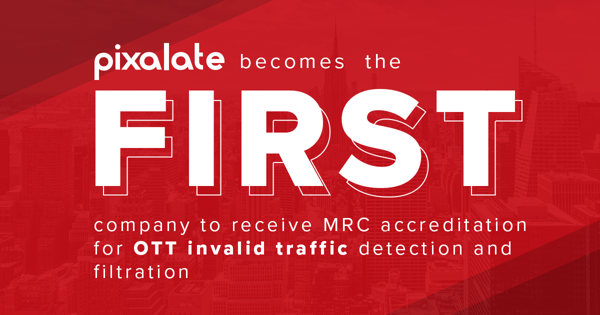
This week's review of ad fraud and quality in the digital advertising space.

Pixalate, the world’s most comprehensive ad fraud detection and prevention platform, has become the first company to receive accreditation from the Media Rating Council (MRC) for Sophisticated Invalid Traffic (SIVT) detection and filtration for over-the-top (OTT) video ad impressions. This groundbreaking achievement positions Pixalate as the only currently accredited solution for marketers to protect their growing OTT advertising investments. Pixalate also received accreditation for its over-the-top (OTT) served video ad impression tracking.

"[Pixalate] is now equipped to measure ad fraud on OTT platforms," wrote MediaPost. "Given the rapid growth of OTT by consumers and marketers, there has been a need to measure OTT viewership and verify authenticity and impressions."
"While the OTT environments may not be as susceptible to some of the traditional invalid traffic in the sense of simple bots/spiders/crawlers, ad fraud is still a pervasive issue across OTT channels," Amy King, vice president, product marketing at Pixalate, told MediaPost. Read more.

With its latest MRC accreditations, Pixalate is now the industry’s first and only accredited solution for ad fraud detection and prevention in Connected TV/OTT. According to a 2018 survey of U.S. agencies and marketers, inventory quality — i.e. verified and fraud-free inventory — is the No. 2 challenge in the Connected TV/OTT advertising space. That’s because, until now, nobody could measure (and therefore prevent) ad fraud in OTT.
Read our blog to learn more about the industry's need for OTT ad fraud detection and filtration.

"Two years after Facebook extended its Audience Network ad network to the connected-TV market, Facebook is shutting down the connected-TV side of its ad network and will stop selling ads inside publishers’ OTT apps by January 2019, according to a company spokesperson," reported Digiday.
"While Facebook is exiting the connected-TV ad market with its ad network, the company has not abandoned the market altogether," added Digiday. "The company has its own Facebook Watch OTT app, which gives Facebook at least some OTT inventory around which it can pitch advertisers looking for TV-like inventory"

Per eMarketer, 37.2% of U.S. households have a Smart TV in 2018, up 16% compared to 2017. "The increased usage of streaming video services like Netflix or Amazon Prime Video combined with a lower barrier of entry has led to a rapid uptake in smart TV ownership," wrote eMarketer. Smart TVs are one component of the larger Connected TV (CTV) and over-the-top (OTT) ecosystem.
Sign up for our blog to stay updated with new stats, trends, and analysis of digital ad fraud.
*By entering your email address and clicking Subscribe, you are agreeing to our Terms of Use and Privacy Policy.
These Stories on Weekly Recaps
*By entering your email address and clicking Subscribe, you are agreeing to our Terms of Use and Privacy Policy.

Disclaimer: The content of this page reflects Pixalate’s opinions with respect to the factors that Pixalate believes can be useful to the digital media industry. Any proprietary data shared is grounded in Pixalate’s proprietary technology and analytics, which Pixalate is continuously evaluating and updating. Any references to outside sources should not be construed as endorsements. Pixalate’s opinions are just that - opinion, not facts or guarantees.
Per the MRC, “'Fraud' is not intended to represent fraud as defined in various laws, statutes and ordinances or as conventionally used in U.S. Court or other legal proceedings, but rather a custom definition strictly for advertising measurement purposes. Also per the MRC, “‘Invalid Traffic’ is defined generally as traffic that does not meet certain ad serving quality or completeness criteria, or otherwise does not represent legitimate ad traffic that should be included in measurement counts. Among the reasons why ad traffic may be deemed invalid is it is a result of non-human traffic (spiders, bots, etc.), or activity designed to produce fraudulent traffic.”

